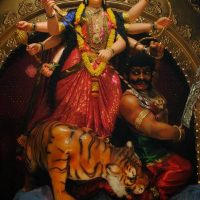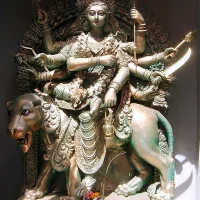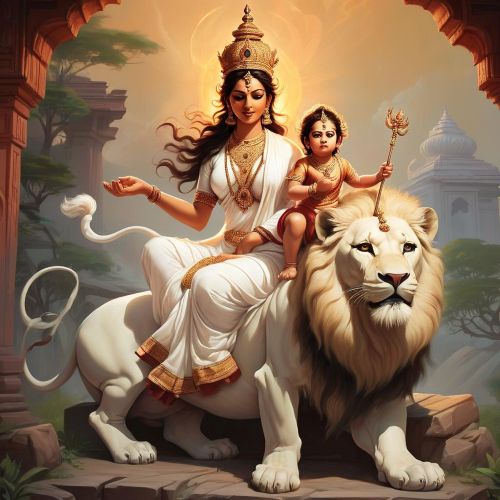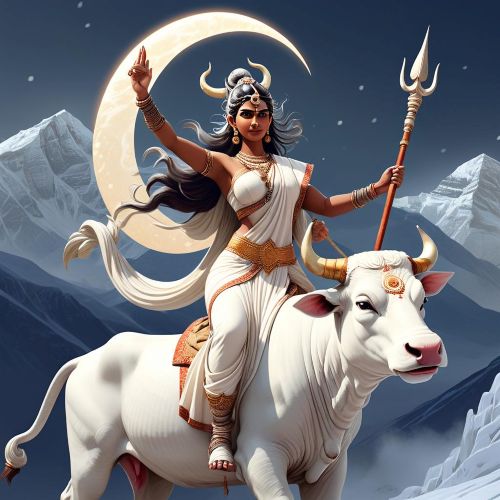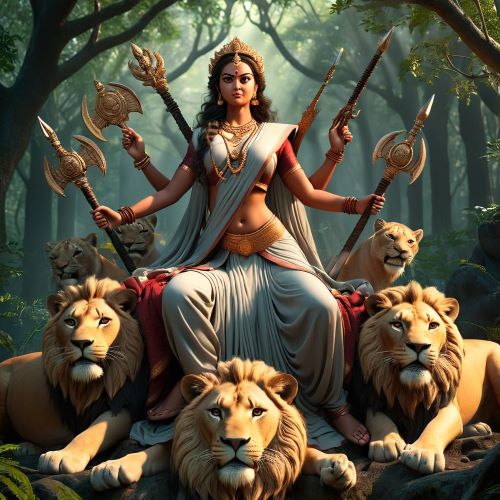Chandraghanta : Goddess of Courage
Listen
At a glance
| Description | |
|---|---|
| Origin | Indian Mythology |
| Classification | Gods |
| Family Members | Shiva (Husband) |
| Region | India |
| Associated With | Courage, Grace, Valor |
Chandraghanta
Introduction
Chandraghanta (Sanskrit: चन्द्रघण्टा) is the third form of Goddess Durga, worshipped on the third day of Navaratri. She is the married aspect of Parvati, representing her transformation into a fierce yet compassionate protector after her union with Lord Shiva. Her name combines “Chandra” (moon) and “Ghanta” (bell), signifying the crescent moon shaped like a bell on her forehead. This unique adornment reflects her role as the goddess who harmonizes serenity with strength. Revered as a warrior goddess who rides into battle against evil, Chandraghanta is also remembered for her calm and motherly nature, reminding devotees that courage and compassion can coexist.
Physical Traits
The iconography of Chandraghanta conveys both majesty and vigilance. She is often depicted with a golden complexion, radiating divine brilliance, and three eyes that symbolize omniscience. On her forehead rests the crescent moon shaped like a bell, which distinguishes her from other forms of Parvati. This moon adornment not only ties her to Shiva but also represents clarity in times of darkness.
Chandraghanta is usually shown mounted on a lion or tiger, powerful symbols of bravery and righteousness. Her vahana, or vehicle, emphasizes her role as the guardian of dharma. She is portrayed with ten arms, each holding sacred objects and weapons such as the trident, sword, mace, bow, and arrow, symbolizing readiness for battle. She also carries a lotus for enlightenment, a water pot for purity, a rosary for devotion, and a ritual bell whose sound dispels fear and negativity. With one hand raised in the Abhaya Mudra, she assures her devotees of protection and fearlessness. Though her appearance radiates strength, her expression remains calm, reflecting the balance between fierceness and benevolence.
Family
As a manifestation of Parvati, Chandraghanta is the daughter of the Himalaya King Himavan and Queen Maina. She is the consort of Lord Shiva, and her transformation into Chandraghanta occurred at the time of their wedding. When Shiva arrived with his unconventional marriage procession—comprising spirits, ghosts, and fierce beings—Parvati’s family grew alarmed at his fearsome appearance. To pacify the situation, Parvati assumed her resplendent form as Chandraghanta, calming Shiva while also reassuring her family. This moment not only highlighted her power but also marked the shift in her identity from a penitent ascetic to a cosmic protector.
Her marriage to Shiva signifies the divine balance of masculine and feminine energies. While Shiva embodies meditative detachment, Chandraghanta represents engaged strength, together forming the union necessary to sustain the universe.
Other names
Chandraghanta is one of the Navadurga, the nine forms of Goddess Durga celebrated during Navaratri. In the wider Shakti tradition, she is revered as an aspect of Mahadevi, the supreme feminine force. Over time, she has been worshipped under several epithets that highlight her divine attributes. She is called Trinetri, the three-eyed goddess who sees beyond the physical world and embodies divine vigilance. As Simhavahini, she is remembered as the lion-rider, symbolizing her unshakable valor and dominance over fear. The name Chandrakala emphasizes her adornment with the crescent moon, a mark of serenity and cosmic connection. She is also known simply as Shakti, the very essence of divine feminine energy that powers creation, preservation, and destruction. Together, these names capture her dual nature as both a fierce protector and a compassionate nurturer, a goddess who balances guardianship with spiritual grace.
Powers and Abilities
Chandraghanta’s powers are rooted in her ability to destroy evil while simultaneously guiding her devotees toward peace. Her most symbolic attribute is the bell on her forehead. Its celestial resonance is believed to terrify demons and cleanse the surrounding atmosphere of negativity.
As a warrior goddess, she is invoked for her capacity to annihilate asuras (demons) and restore cosmic balance. Legends describe her participation in battles against formidable demons like Tarkasura and Jatukasura, where she wielded her divine weapons with unmatched strength. The trident embodies her control over the three worlds—heaven, earth, and the underworld—while the sword represents clarity in decision-making and the severing of ignorance.
Yet Chandraghanta is not defined only by aggression. She is equally revered for her protective aura that shields her devotees from fear and danger. For spiritual seekers, she grants discipline, focus, and the ability to overcome doubts during meditation. She represents the combined energies of Brahma, Vishnu, and Shiva, reminding humanity that divine power is not unidimensional but a harmonious blend of creativity, preservation, and destruction.
Her duality is her greatest strength—she can be fiery and wrathful toward evil yet endlessly compassionate toward her devotees. This quality has made her a patron deity for warriors, spiritual practitioners, and ordinary people seeking courage in daily life.
Modern Day Influence
Chandraghanta’s relevance continues to thrive in contemporary times, especially during the Navaratri festival. On the third day, devotees worship her with offerings of milk, sweets, and prayers, seeking courage, tranquility, and divine protection. Her imagery—resplendent, fearless, and calm—continues to inspire art, temple rituals, and devotional hymns.
In modern cultural discourse, Chandraghanta has also come to symbolize empowered womanhood. Her ability to balance serenity with ferocity resonates with feminist interpretations of divine strength. She is often viewed as an archetype for women navigating roles that require both compassion and assertiveness.
Her presence extends beyond religious rituals into popular culture, literature, and digital media. Platforms dedicated to mythology reinterpret her stories for global audiences, framing her as a figure of resilience and balance. Artists portray her dual qualities in paintings, music, and dance, emphasizing that strength need not negate grace.
For many, Chandraghanta’s story serves as a metaphor for navigating challenges in modern life. Entrepreneurs draw inspiration from her determination, spiritual seekers from her discipline, and social reformers from her commitment to justice. Her symbolism reminds individuals that true courage is not brute force but the strength to act with purpose, protect with compassion, and remain serene even in adversity.
Related Images
Source
Wikipedia contributors. (2023). Chandraghanta. Wikipedia. https://en.wikipedia.org/wiki/Chandraghanta
Pattanaik, D. (2010). 7 Secrets of the Goddess. Westland Publications.
Kinsley, D. R. (1986). Hindu Goddesses: Visions of the Divine Feminine in the Hindu Religious Tradition. University of California Press.
Frawley, D. (1994). Tantric Yoga and the Wisdom Goddesses. Motilal Banarsidass.
Bhattacharyya, N. N. (1999). History of the Tantric Religion. Manohar Publishers.
Brown, C. M. (1998). The Triumph of the Goddess: The Canonical Models and Theological Visions of the Devi-Bhagavata Purana. SUNY Press.
Indian Mythology Stories. (2023). The story of Goddess Chandraghanta. https://indianmythology.co.in/story-of-goddess-chandraghanta/
Frequently Asked Questions
What is lorem Ipsum?
I am text block. Click edit button to change this text. Lorem ipsum dolor sit amet, consectetur adipiscing elit. Ut elit tellus, luctus nec ullamcorper mattis, pulvinar dapibus leo.
What is lorem Ipsum?
I am text block. Click edit button to change this text. Lorem ipsum dolor sit amet, consectetur adipiscing elit. Ut elit tellus, luctus nec ullamcorper mattis, pulvinar dapibus leo.
What is lorem Ipsum?
I am text block. Click edit button to change this text. Lorem ipsum dolor sit amet, consectetur adipiscing elit. Ut elit tellus, luctus nec ullamcorper mattis, pulvinar dapibus leo.
What is lorem Ipsum?
I am text block. Click edit button to change this text. Lorem ipsum dolor sit amet, consectetur adipiscing elit. Ut elit tellus, luctus nec ullamcorper mattis, pulvinar dapibus leo.
What is lorem Ipsum?
I am text block. Click edit button to change this text. Lorem ipsum dolor sit amet, consectetur adipiscing elit. Ut elit tellus, luctus nec ullamcorper mattis, pulvinar dapibus leo.



